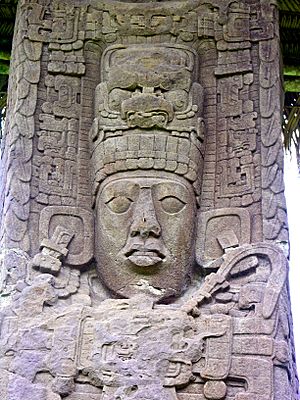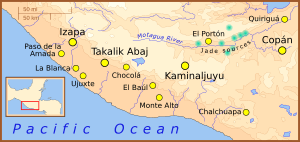Third Tikal–Calakmul War facts for kids
Quick facts for kids Third Tikal–Calakmul War |
|||||||||
|---|---|---|---|---|---|---|---|---|---|
| Part of Tikal–Calakmul wars | |||||||||
 K'ak' Tiliw Chan Yopaat, previously known as Cauac Sky, was the leader of Quiriguá's revolution against Copán |
|||||||||
|
|||||||||
| Belligerents | |||||||||
| Commanders and leaders | |||||||||
The Third Tikal–Calakmul War was a major conflict between two powerful ancient Maya cities: Tikal and Calakmul. These cities were like superpowers during the Classic period of the Maya civilization. This war was the third in a series of big fights between them.
During this war, a smaller city called Quiriguá played a very important part. Quiriguá decided to break away from Copán, which was a close friend of Tikal. Then, Quiriguá joined forces with Calakmul, changing the balance of power.
Contents
Why Did the War Start?
After a big defeat for Calakmul in 695 AD, the fighting between Calakmul and Tikal mostly calmed down. However, around 720 AD, conflicts slowly began to increase again.
Even though Tikal was becoming stronger and richer, some important cities like Naranjo, Dos Pilas, and El Peru were still controlled by Calakmul.
Between 733 and 736 AD, Tikal won a battle and captured an important noble from Calakmul. To celebrate this victory, Tikal built an altar with a sculpture showing the captured noble tied up by Tikal soldiers. This showed Tikal's growing strength.
Quiriguá's Big Change
Quiriguá was a smaller city in the southern part of the Maya lands. It eventually grew to have about 16,000 people. For a long time, Quiriguá was under the control of the larger city of Copán.
In 724 AD, Uaxaclajuun Ubʼaah Kʼawiil, the ruler (called an Ajaw) of Copán, chose Kʼakʼ Tiliw Chan Yopaat to be the local ruler of Quiriguá.
But in 734 AD, K’ak Tiliw Chan Yopaat made a bold move. He declared himself "k’uhul ajaw" at Altar M in Quiriguá. This meant he was declaring Quiriguá's independence from Copán. This decision led to a four-year fight for freedom.
Two years later, in 736 AD, Wamaw Kʼawiil, the ruler of Calakmul, met with K’ak Tiliw Chan Yopaat. Several ambassadors from Calakmul were also there. This meeting likely sealed the alliance between Quiriguá and Calakmul.
On April 27, 738 AD, something surprising happened: Uaxaclajuun Ub'aah K'awiil, the ruler of Copán, was captured by K'ak' Tiliw Chan Yopaat. Since there were no big battles reported around Copán or Quiriguá at that time, historians believe he was probably captured in a different way, not during a fight.
Just a few days later, on May 3, 738 AD, Uaxaclajuun Ub'aah K'awiil faced a public trial. During a special ceremony, he was executed by an axe. This important event is recorded in history as an "axe event."
What Happened After Quiriguá's Revolution?
Even though Quiriguá was allied with Calakmul, it was never directly controlled by Calakmul. At the same time, Copán never tried to take Quiriguá back. This was likely because Copán's leaders were afraid of Calakmul's military strength.
The alliance was good for both Quiriguá and Calakmul. Quiriguá was important because it was located on several major trade routes, which helped Calakmul's trade.
In 743 AD, Tikal captured El Peru, and in 744 AD, it took Naranjo. These victories greatly weakened Calakmul. They destroyed Calakmul's once strong network of allies, smaller states under its control, and its trade routes.
The End of the War and Beyond

After 790 AD, Calakmul lost most of its northern lands to other cities on the Yucatán Peninsula. In 810 AD, three stone monuments called stelae were put up in Calakmul.
March 20, 829 AD, marked the beginning of a new cycle on the Maya calendar. Usually, new stelae would be put up to mark such an event, but none were in Calakmul. The last stela record in Calakmul was raised in 899 AD (possibly 909 AD). After this, a few more stelae were put up, but they seemed to be copies rather than original writings. It was as if people were trying to keep the Maya civilization from collapsing.
This period was part of the Classic Maya collapse, a time when many major Maya cities, including Tikal, saw a huge drop in their populations.
|



